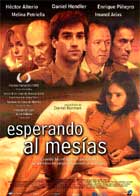
Waiting for the Messiah (Esperando al mesías) 2000
Distributed by LAVA - Latin American Video Archives, 124 Washington Place, New York, NY 10014; 212-243-4804
Produced by Diego Dubcovsky, Daniel Burman
Directed by Daniel Burman
VHS, color, 93 min.
College - Adult
Drama, Latin American Studies, Jewish Studies, South American Studies
Date Entered: 12/10/2003
Reviewed by Sean Knowlton, University of Colorado at BoulderSet in a Buenos Aires reeling from the effects of a crashing, dehumanizing global economy, Waiting for the Messiah thoughtfully explores the universal theme of the human condition through the lives of Santamaría (Enrique Piñeyro) and Ariel (Daniel Hendler). Using the word burbuja or bubble as a metaphor for his insular life in the Jewish neighborhood of El Once, Ariel wants to experience more out of life than simply working in the family restaurant and marrying his Jewish girlfriend. The director and writer, Daniel Burman, successfully captures Ariel’s identity crisis in a realistic and personal way that does not resort to stereotyping or melodrama.
Santamaría, the other protagonist, is a banker who loses his job due to the tumbling international market and his home to an unforgiving wife. Living on the streets, he subsists off of donations from grateful people whose stolen identification he recovers from the trash. In contrast with Ariel’s dilemma, Santamaría strives to return to his familiar bubble. He seeks solace and companionship in a woman awaiting her husband’s return from prison. In this film, Burman profoundly explores the humanity of each character and looks well beyond a mere label – a Jew, a homeless man, a lonely wife, a lesbian, a widower – to reveal the intrinsic worth of each individual.
Although not a documentary on Jewish cultural life in Argentina, Burman highlights aspects of this religion through glances at its ceremonies, such as Hanukkah, a Bar-Mitzvah, and a wedding. By doing so, he portrays the religion in an accessible and sensitive way. This is a significant act as anti-Semitism in Argentina is still a reality and his approach would not be lost on an Argentine audience.
The film has excellent cinematography and acceptable sound. The English language subtitles that accompany the Spanish dialogue are generally acceptable.
This film is of interest to those who study diversity issues, the Jewish Diaspora, South American culture and the Spanish language. It is recommended for college students, adult viewers, and the libraries who serve them.